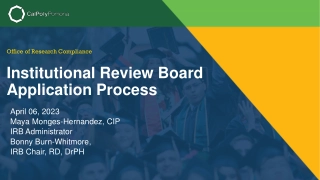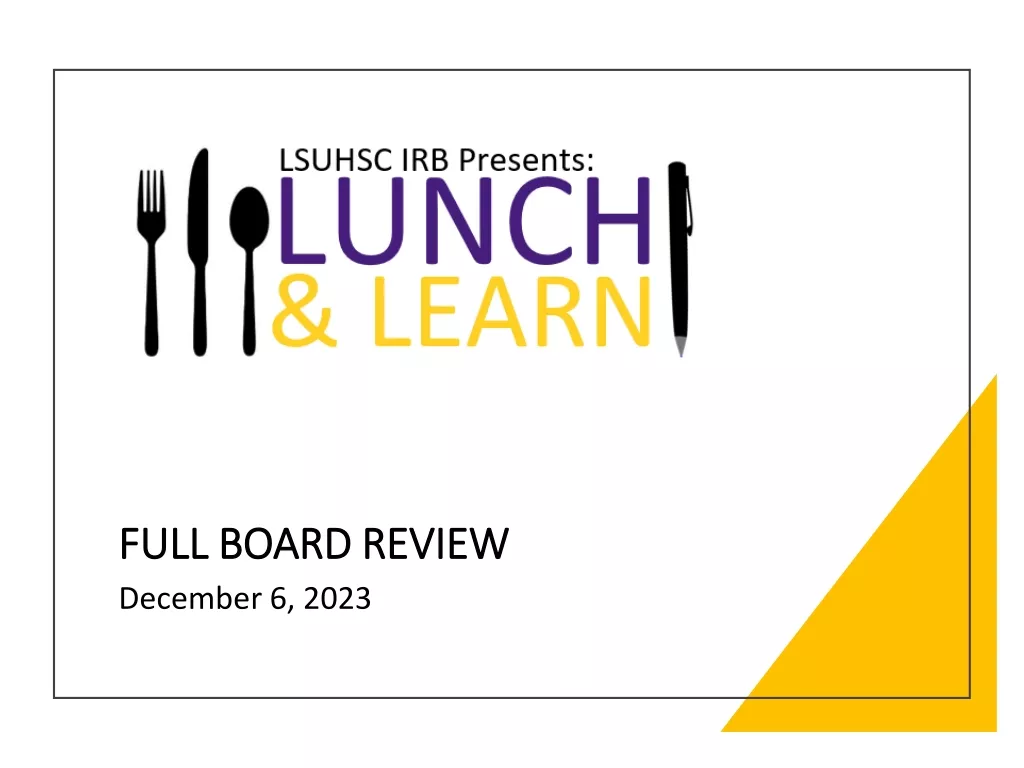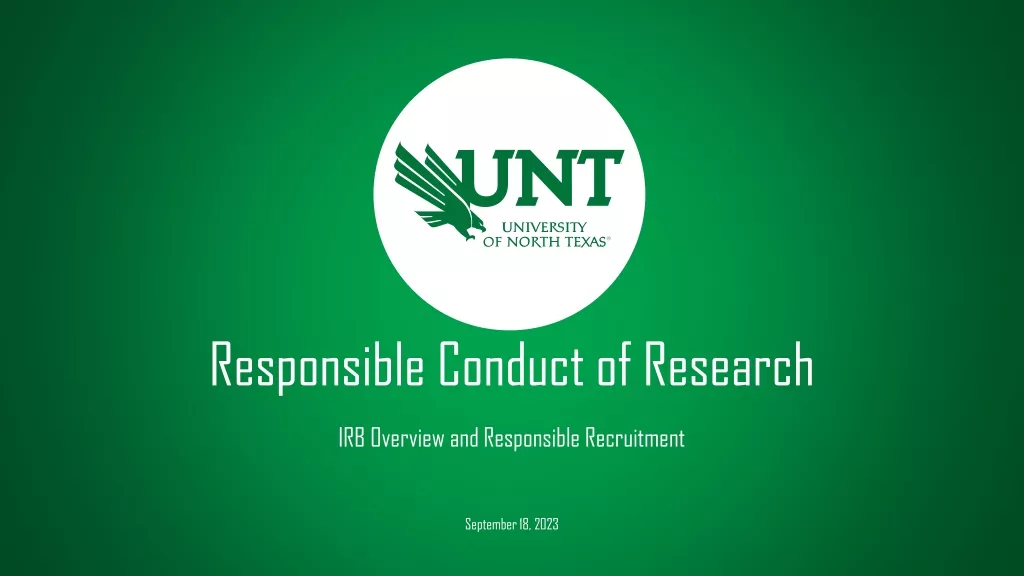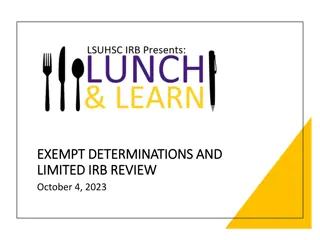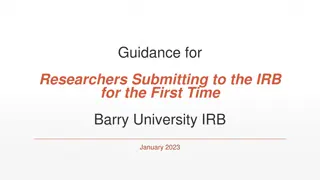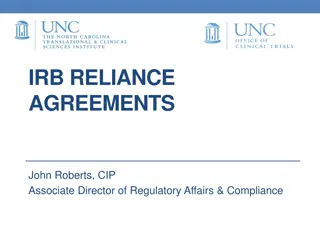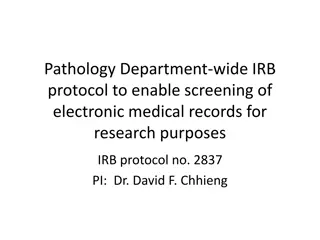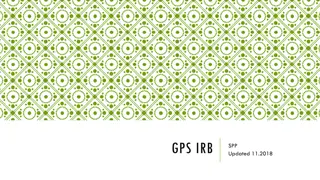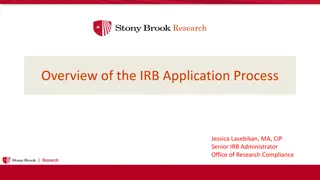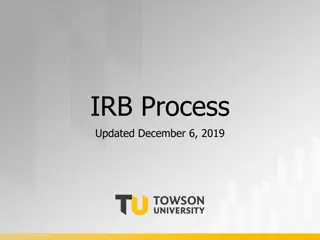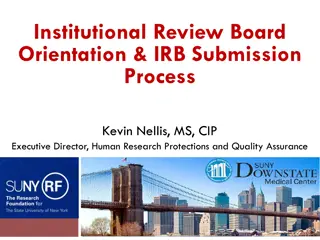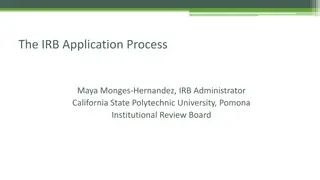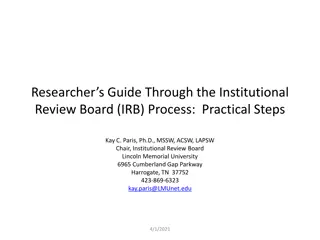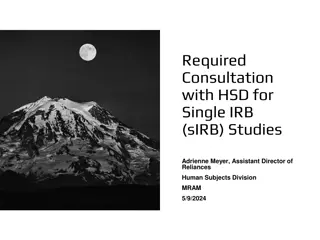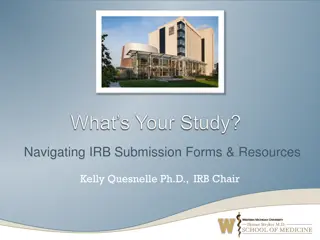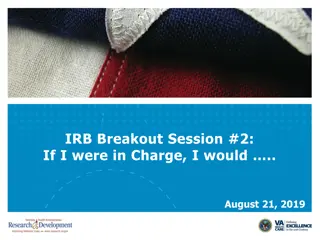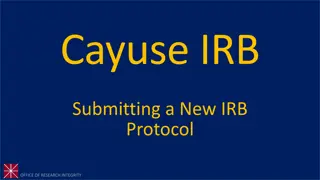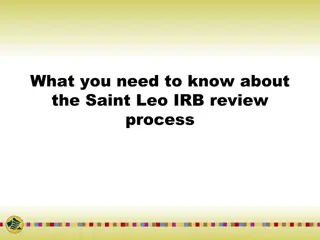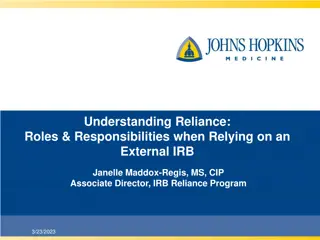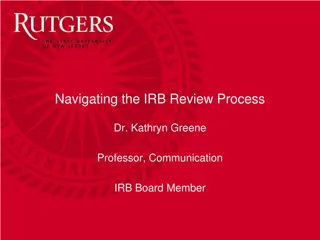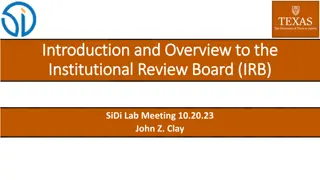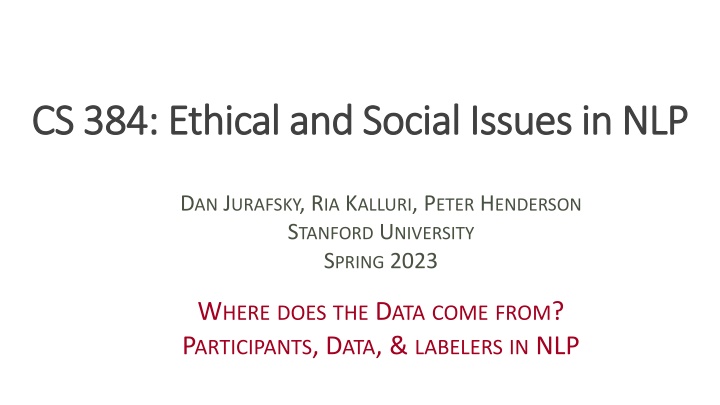
Ethical and Social Issues in Natural Language Processing
Explore the ethical and social issues surrounding data collection in NLP, with insights into historical cases like the Nuremberg Code and the Tuskegee Study. Learn about the importance of human subjects' protection and the implications for research ethics in NLP.
Download Presentation

Please find below an Image/Link to download the presentation.
The content on the website is provided AS IS for your information and personal use only. It may not be sold, licensed, or shared on other websites without obtaining consent from the author. If you encounter any issues during the download, it is possible that the publisher has removed the file from their server.
You are allowed to download the files provided on this website for personal or commercial use, subject to the condition that they are used lawfully. All files are the property of their respective owners.
The content on the website is provided AS IS for your information and personal use only. It may not be sold, licensed, or shared on other websites without obtaining consent from the author.
E N D
Presentation Transcript
CS 384: Ethical and Social Issues in NLP CS 384: Ethical and Social Issues in NLP DAN JURAFSKY, RIA KALLURI, PETER HENDERSON STANFORD UNIVERSITY SPRING 2023 WHERE DOES THE DATA COME FROM? PARTICIPANTS, DATA, & LABELERS IN NLP
Nuremberg Code of 1947 Ten principles of research developed for the "Doctors' Trial": American judges trying Nazi doctors accused of murder and torture in their human experiments in the concentration camps. 1. The voluntary consent of the human subject is essential. 2. The experiment should be .... for the good of society 6. risk ... should never exceed ... the humanitarian importance of the problem 9. ...subject should be at liberty to bring the experiment to an end... Shuster, Evelyne. 1997. "Fifty years later: the significance of the Nuremberg Code." New England Journal of Medicine 337, 20: 1436-1440. Videos and photos from Holocaust Memorial Museum (trigger warning)
United States Public Health Services Study United States Public Health Services Studyin Tuskegee in Tuskegee 40-year study by the US Public Health Service begun in 1932 Goal: observe natural history of untreated syphilis Wikimedia Commons, from National Archives Enrolled 600 poor African American sharecropper men 400 with syphilis, 200 controls Told they would be treated for "bad blood" Were not treated, merely studied Were not told they had syphilis Sexual partners not informed By 1940s penicillin becomes standard treatment for syphilis Subjects were not told or given penicillin
United States Public Health Services Study United States Public Health Services Studyin Tuskegee in Tuskegee 1964 Protest letter from a doctor who reads one of the papers I am utterly astounded by the fact that physicians allow patients with a potentially fatal disease to remain untreated when effective therapy is available 1965 Memo from authors: This is the first letter of this type we have received. I do not plan to answer this letter
United States Public Health Services Study United States Public Health Services Studyin Tuskegee in Tuskegee 1966 Peter Buxtun, a PHS researcher in San Francisco, sent a letter to the CDC but study was not stopped. 1972 Buxton goes to the press. Senator Edward Kennedy calls congressional hearings 1974 Congress passes National Research Act NY Times July 26, 1972
Stanford prison experiment Conducted by Philip Zimbardo in 1971 (in the basement of Jordan Hall). Modeled after the "Toyon Hall experiment", a final project of one of the students in his Psychology seminar Le Texier, Thibault. "Debunking the Stanford Prison Experiment." American Psychologist (2019).
Stanford prison experiment College students were chosen to be either "prisoners" or "guards" Results as published by Zimbardo: Guards humiliated and abused prisoners Prisoners became depersonalized Evidence for "ugly side of human nature" Experiment stopped after 6 days Le Texier, Thibault. "Debunking the Stanford Prison Experiment." American Psychologist (2019).
Stanford prison experiment Scientific and ethical flaws Participants were not random: respondents to an ad for a psychological study of prison life. Carnahan and MacFarland 2007: word "prison" selects personalities Guards were told the expected results ("conditions which lead to mob behavior, violence") Researchers intervened in experiment to instruct guards how to behave ("We can create a sense of frustration. We can create fear") Guards not told they were participants Researcher refused to allow prisoner participants to leave experiment. Le Texier, Thibault. "Debunking the Stanford Prison Experiment." American Psychologist (2019).
National Research Act 1974 Required institutional review of all federally funded experiments Institutional Review Boards (IRBs) Created National Commission for the Protection of Human Subjects of Biomedical and Behavioral Research Issued Belmont Report in 1976/1979 The Common Rule: Title 45, Part 46 of the Code of Federal Regulations: Protection of Human Subjects. Informed consent
The Belmont Report Three Basic Ethical Principles 1. Respect for Persons Individuals should be treated as autonomous agents "Informed Consent" Persons with diminished autonomy are entitled to protection
The Belmont Report Three Basic Ethical Principles 2. Benificence Do no harm Maximize possible benefits and minimize possible harms.
The Belmont Report Three Basic Ethical Principles 3. Justice Who ought to receive the benefits of research and bear its burdens? Fair procedures and outcomes in the selection of research subjects Advances should benefit all
The Common Rule The Federal Policy for the Protection of Human Subjects 45 CFR part 46 https://www.hhs.gov/ohrp/regulations-and-policy/regulations/45-cfr-46/index.html
IRB: Institutional Review Board Internal to each academic institution Most universities (including Stanford) have 2 distinct boards Medical and Non-medical https://researchcompliance.stanford.edu/panels/h Reviews all human subjects experiments Consent forms Risks/benefits Contributions of research Protection of privacy
The Common Rule Human subject: a living individual about whom an investigator (professional or student) conducting research: (i) Obtains information through intervention or interaction with the individual, and uses, studies, or analyzes the information ; or (ii) Obtains, uses, studies, analyzes, or generates identifiable private information .
Exempt Research Research that only includes survey procedures, interview procedures, or observation of public behavior (including visual or auditory recording) if one of:: (i) the identity of the human subjects cannot readily be ascertained, (ii) Any disclosure of the human subjects' responses outside the research would not place the subjects at risk of criminal or civil liability or be damaging to the subjects' financial standing, employability, educational advancement, or reputation; or (iii) The information obtained is recorded by the investigator in such a manner that the identity of the human subjects can readily be ascertained, and an IRB conducts a limited IRB review [When] consent is not required: Secondary research uses of identifiable private information if the identifiable private information [is] publicly available;
Deceiving participants Belmont Report: "incomplete disclosure" is allowed when: (1) incomplete disclosure is truly necessary to accomplish the goals of the research (2) there are no undisclosed risks to subjects that are more than minimal, and (3) there is an adequate plan for debriefing subjects, when appropriate, and for dissemination of research results to them
CITI training If you intend to be on any research project that runs human subjects You must do CITI certification Required by Stanford IRB Required for all federally funded research Short course https://researchcompliance.stanford.edu/panels/h s/forms/training/citi
3. What about data from corpora? Authors
Using social media data: author From IRB perspective this kind of corpus data is exempt if it is public E.g., public twitter data But are there still questions?
Issues with social media data: author Williams, M. L., Burnap, P., Towards an Ethical Framework for Publishing Twitter Data in Social Research: Taking into Account Users Views, Online Context and Algorithmic Estimation. Sociology, 51(6), 1149 1168. "Are consent, confidentiality and anonymity required where the research is conducted in a public place where people would reasonably expect to be observed by strangers?" What counts as a public vs. private space on/off the web? If people are whispering in a public square is that private? What about religious ceremonies?
Issues with social media data: author Williams, M. L., Burnap, P., Towards an Ethical Framework for Publishing Twitter Data in Social Research: Taking into Account Users Views, Online Context and Algorithmic Estimation. Sociology, 51(6), 1149 1168. What are the potential harms? Demographic info (age, ethnicity, religion, sexual orientation) Associations (membership in groups or associations with particular people) Communications that are person or potentially harmful (extreme options? Illegal activities?) Others?
What do Twitter authors think? Casey Fiesler and Nicholas Proferes. 2018. Participant Perceptions of Twitter Research Ethics. Social Media + Society, 4(1). 22
Fiesler et al
responses, with an average length of 35 words (median=23.5; SD=35). ethical attitudes among our respondents. Researchers Codes of Ethics We combined structured and semi-structured survey questions to understand respondents personal codes of ethics for research with online data. The most frequent responses to the open-ended question asking participants to share their personal codes of ethics described strategies for protecting individuals, securing consent, and balancing risks to participants with larger (i.e., societal) benefits. Respondents also cited diverse ethical principles, including the Belmont Report and Common Rule, guidance from ethics review boards, individual sites Terms of Service, the Hippocratic Oath, and variations on the Golden Rule. The role of context in guiding researcher decisions was also a prominent theme, as were changing personal codes of ethics. We explore descriptive statistics and qualitative data highlighting these themes below. Data Analysis We downloaded and imported participant data into SPSS for analysis. We cleaned the data by removing cases missing more than 10% of responses. As the presentation of findings is largely descriptive, we did not impute missing data; these cases were ignored in individual analyses. For the open-ended question, each author independently reviewed the responses and created a set of codes to apply to the corpus. After three iterative rounds of comparison, authors agreed on an 11-factor coding scheme (see Table 2). Two authors then coded the full set of responses for the 11 themes allowing for multiple codes per response and agreed on 97% of the codes. For the final 3%, we discussed What do Twitter researchers do/think? areas of disagreement until we reached a consensus. Key findings from these analyses are presented below. Protecting data subjects Protection of individual subjects was the most prominent theme in free-text responses, and responses took many forms. A male research faculty member working in an English department characterized protection as de- identification: FINDINGS We present finding across four areas: describing how researchers characterize their codes of ethics; identifying areas of agreement and disagreement among respondents; analyzing researchers impressions of their colleagues ethical standards; and identifying an emergent code of Vitak, Jessica, Katie Shilton, and Zahra Ashktorab. 2016. "Beyond the Belmont principles: Ethical challenges, practices, and beliefs in the online data research community." ACM CSCW, pp. 941-953. 2016. Code Public Data Definition Only using public data / public data being okay to collect and analyze Example Statements In general, I feel that what is posted online is a matter of the public record, though every case needs to be looked at individually in order to evaluate the ethical risks. Do No Harm Comments related to the Golden Rule Golden rule, do to others what you would have them do to you. Informed Consent Always get informed consent / stressing importance of informed consent I think at this point for any new study I started using online data, I would try to get informed consent when collecting identifiable information (e.g. usernames). Greater Good Data collection should have a social benefit The work I do should address larger social challenges, and not just offer incremental improvements for companies to deploy. Established Guidelines Including Belmont Report, IRBs Terms of Service, legal frameworks, community norms I generally follow the ethical guidelines for human subjects research as reflected in the Belmont Report and codified in 45.CFR.46 when collecting online data. Risks vs. Benefits Discussion of weighing potential harms and benefits or gains I think I focus on potential harm, and all the ethical procedures I put in place work towards minimizing potential harm. Protect Participants Methods to protect individual: data aggregation, deleting PII, anonymizing/obfuscating data I aggregate unique cases into larger categories rather than removing them from the data set. Deception Justifying its (non) use in research I use deception for participatory research and debrief at the end. Data Judgments Efforts to not make inferences or judge participants or data Do not expose users to the outside world by inferring features that they have not personally disclosed. Transparency Contact with participants or methods of informing participants about research I generally choose not to scrape/crawl public sources. I prefer to engage individual participants in the data collection process, and to provide them with explicit information about data collection practices. In Flux One's code of ethics is under development, context-dependent, or otherwise in flux It very much depends on the nature of the data. Table 2. Emergent themes from qualitative responses regarding researchers personal code of ethics
responses, with an average length of 35 words (median=23.5; SD=35). ethical attitudes among our respondents. Researchers Codes of Ethics We combined structured and semi-structured survey questions to understand respondents personal codes of ethics for research with online data. The most frequent responses to the open-ended question asking participants to share their personal codes of ethics described strategies for protecting individuals, securing consent, and balancing risks to participants with larger (i.e., societal) benefits. Respondents also cited diverse ethical principles, including the Belmont Report and Common Rule, guidance from ethics review boards, individual sites Terms of Service, the Hippocratic Oath, and variations on the Golden Rule. The role of context in guiding researcher decisions was also a prominent theme, as were changing personal codes of ethics. We explore descriptive statistics and qualitative data highlighting these themes below. Data Analysis We downloaded and imported participant data into SPSS for analysis. We cleaned the data by removing cases missing more than 10% of responses. As the presentation of findings is largely descriptive, we did not impute missing data; these cases were ignored in individual analyses. For the open-ended question, each author independently reviewed the responses and created a set of codes to apply to the corpus. After three iterative rounds of comparison, authors agreed on an 11-factor coding scheme (see Table 2). Two authors then coded the full set of responses for the 11 themes allowing for multiple codes per response and agreed on 97% of the codes. For the final 3%, we discussed areas of disagreement until we reached a consensus. Key findings from these analyses are presented below. Protecting data subjects Protection of individual subjects was the most prominent theme in free-text responses, and responses took many forms. A male research faculty member working in an English department characterized protection as de- identification: FINDINGS We present finding across four areas: describing how researchers characterize their codes of ethics; identifying areas of agreement and disagreement among respondents; analyzing researchers impressions of their colleagues ethical standards; and identifying an emergent code of Code Public Data Definition Only using public data / public data being okay to collect and analyze Example Statements In general, I feel that what is posted online is a matter of the public record, though every case needs to be looked at individually in order to evaluate the ethical risks. Do No Harm Comments related to the Golden Rule Golden rule, do to others what you would have them do to you. Informed Consent Always get informed consent / stressing importance of informed consent I think at this point for any new study I started using online data, I would try to get informed consent when collecting identifiable information (e.g. usernames). Vitak, Jessica, Katie Shilton, and Zahra Ashktorab. 2016. "Beyond the Belmont principles: Ethical challenges, practices, and beliefs in the online data research community." ACM CSCW, pp. 941-953. 2016. Greater Good Data collection should have a social benefit The work I do should address larger social challenges, and not just offer incremental improvements for companies to deploy. Established Guidelines Including Belmont Report, IRBs Terms of Service, legal frameworks, community norms I generally follow the ethical guidelines for human subjects research as reflected in the Belmont Report and codified in 45.CFR.46 when collecting online data. Risks vs. Benefits Discussion of weighing potential harms and benefits or gains I think I focus on potential harm, and all the ethical procedures I put in place work towards minimizing potential harm. Protect Participants Methods to protect individual: data aggregation, deleting PII, anonymizing/obfuscating data I aggregate unique cases into larger categories rather than removing them from the data set. Deception Justifying its (non) use in research I use deception for participatory research and debrief at the end. Data Judgments Efforts to not make inferences or judge participants or data Do not expose users to the outside world by inferring features that they have not personally disclosed. Transparency Contact with participants or methods of informing participants about research I generally choose not to scrape/crawl public sources. I prefer to engage individual participants in the data collection process, and to provide them with explicit information about data collection practices. In Flux One's code of ethics is under development, context-dependent, or otherwise in flux It very much depends on the nature of the data. Table 2. Emergent themes from qualitative responses regarding researchers personal code of ethics
Some proposals OK to programmatically collect data without explicit consent But seek informed consent for all directly quoted content in publications Twitter's view is that users retain rights to the content they post. Williams, M. L., Burnap, P., Towards an Ethical Framework for Publishing Twitter Data in Social Research: Taking into Account Users Views, Online Context and Algorithmic Estimation. Sociology, 51(6), 1149 1168.
More suggestions Transparency with research communities Ask/inform Ethical deliberation with colleagues (in addition to IRBs) Be cautious about sharing results that include potentially identifiable outliers Vitak, Jessica, Katie Shilton, and Zahra Ashktorab. 2016. "Beyond the Belmont principles: Ethical challenges, practices, and beliefs in the online data research community." ACM CSCW, pp. 941-953. 2016.
4. What about data from corpora? Data and Labelers
More ethical issues re: data NLP systems (and machine learning models) can "reproduce or amplify unwanted societal biases reflected in training data" (Gebru et al 2020). Data issues can cause NLP systems to fail for some populations (children, the elderly, speakers of dialects, minority languages) Data has scientific implications What is the training/test split? Is the data appropriate for the task? How was the data labeled?
Datasheets, data statements, etc Dataset creators: Encourage careful reflection on assumptions, risks, implications Dataset consumers: Support informed decisions about using a dataset
Data sheets Timnit Gebru, Jamie Morgenstern, Briana Vecchione, Jennifer Wortman Vaughan, Hanna Wallach, Hal Daum III, Kate Crawford. 2020. Datasheets for Datasets. Arxiv. Motivation Why collected, who, how funded Pre-processing Uses Composition How many instances, how sampled, data split Distribution Maintenance Collection Process How collected, how metadata assigned, IRB, timeline, consent
Data Statements Emily M. Bender and Batya Friedman. 2018. Data statements for NLP: Toward mitigating system bias and enabling better science. TACL 6, 587 604. A "design solution and professional practice" for NLP Should be included in NLP writings: papers presenting new datasets papers reporting experimental work with datasets system documentation
Data Statements Sample Hate Speech Twitter (Waseem and Hovy 2016) https:// github.com/zeerakw/hatespeech CURATION RATIONALE: In order to study the automatic detection of hate speech LANGUAGE VARIETY: Twitter search API in late 2015. Information about which varieties of English are represented is not available, but at least Australian (en-AU) and US (en- US) mainstream Englishes are both included. BCP-47 TAG: https://tools.ietf.org/rfc/bcp/bcp47.txt SPEAKER DEMOGRAPHIC: Speakers were not directly approached for inclusion in this dataset and thus could not be asked for demographic information. More than 1,500 different Twitter accounts are included. Emily M. Bender and Batya Friedman. 2018. Data statements for NLP: Toward mitigating system bias and enabling better science. TACL 6, 587 604.
Data Statement Sample (con't) ANNOTATOR DEMOGRAPHIC: This dataset includes annotations from both crowdworkers and experts. A total of 1,065 crowdworkers were recruited through Crowd Flower, primarily from Europe, South America, and North America. The expert annotators were recruited specifically for their understanding of intersectional feminism. They ranged in age from 20 40 years, included 3 men and 13 women, and gave their ethnicity as SPEECH SITUATION: All tweets were initially published between April 2013 and December 2015. Tweets represent informal, . TEXT CHARACTERISTICS: For racist tweets the topic was dominated by Islam and Islamophobia. Emily M. Bender and Batya Friedman. 2018. Data statements for NLP: Toward mitigating system bias and enabling better science. TACL 6, 587 604.
Bender's Question: What language is the paper studying? "Surveys of EACL 2009 (Bender, 2011) and ACL 2015 (Munro, 2015) found 33 81% of papers failed to name the language studied. (It always appeared to be English.) " - Bender and Friedman 2018.
What about labeling? Did the paper use labels from an external dataset or were some data relabeled? Who were they? Experts? Crowdworkers? How were they trained? Are training example given in the paper? How screened? How were they compensated? How aggregated to form final labels? R. Stuart Geiger, Kevin Yu, Yanlai Yang, Mindy Dai, Jie Qiu, Rebekah Tang, Jenny Huang. 2020. Garbage In, Garbage Out? Do Machine Learning Application Papers in Social Computing Report Where Human-Labeled Training Data Comes From? ACM FAT* 2020
What about harms to labelers? E.g., the Kenyan labelers for OpenAI in the reading
Labeler Pay Were the labelers paid minimum wage? Whiting, Mark E., Grant Hugh, and Michael S. Bernstein. "Fair Work: Crowd Work Minimum Wage with One Line of Code." In Proceedings of the AAAI Conference on Human Computation and Crowdsourcing, vol. 7, no. 1, pp. 197-206. 2019.
The community source of the data Labov (1982:173), Wolfram Investigators who have obtained linguistic data from members of a speech community have obligations: To make knowledge of that data available to the community To actively pursue ways to return linguistic favors to the community Rickford 1997 We have "drawn substantially on data from the African American speech community but given relatively little in return." The contributions could include the induction of African Americans into linguistics, the representation of African Americans in our writings, and involvement in courts, workplaces, and schools, especially with respect to the teaching of reading Rickford, John Russell. "Unequal partnership: Sociolinguistics and the African American speech community."Language in Society 26, no. 2 (1997): 161-197.
Case study Famous Google 2003 patent: Proposed to automatically induce information about the user even if, for privacy reasons, the user is purposely trying to conceal it from Google and does not give permission. Question for discussion: Is this OK if Google does not give out the data to anyone else? When is it OK for us to infer demographics of users? Zuboff, Shoshana. 2019. The Age of Surveillance Capitalism
Sample questions for our discussion When and how is it OK to use data from the web? What demographics of users is it OK to infer without permission? When do we need to ask consent for NLP research? For what kinds of NLP papers is it crucial to investigate multiple languages? What human subjects issues should apply to crowdworkers or other data labelers? Who should be an author on a paper? Should we be putting data statements in our class papers? Are there examples of your prior research practices that you now think you might want to change?


